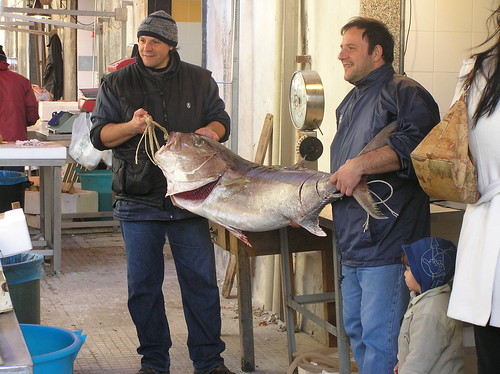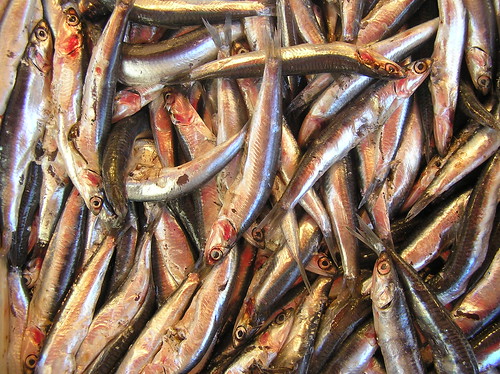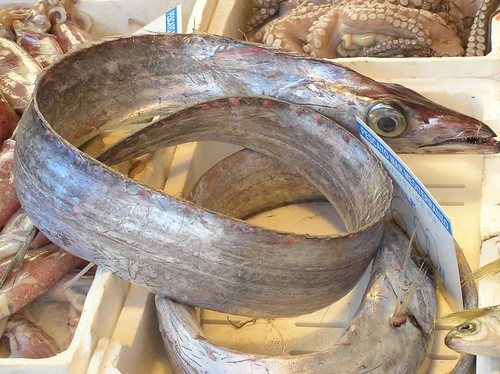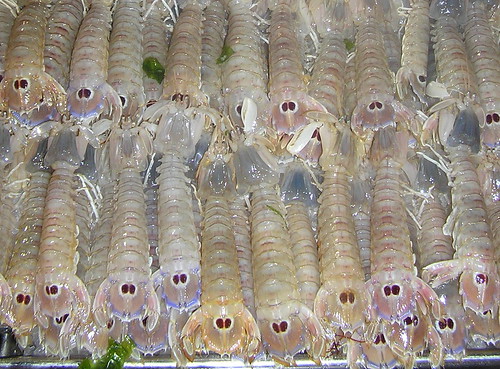-
Posts
189 -
Joined
-
Last visited
Content Type
Profiles
Forums
Store
Help Articles
Posts posted by Pizza Napoletana
-
-
-
Good discussion, however Crema Pasticcera is often flavoured (and always in Campania/ Sorrento/Naples region) with lemon zest.
The recipe in the discussion doesn’t call for lemon zest and doesn’t mention that many Italian may use potato starch instead of flour.
Wheat starch is for sure preferred over potatoes
Franci,
In Italian patisserie they use "Amido" or "Amido di Patate", which is Potato starch......
Ciao
-
Some of the English name in the google traslators may not be very accurate ;-)
For istance Rombo should be Tourbot, or At least I thought so...
The Ionina sea is between the few un-spoiled in Italy.
-
Finally, the biggest fish in the market that day, a nice-looking tuna:

Everybody is impressed (and rightly so), even that kid in the corner. Yum!
Hello, i'm a new member of this forum.
I'm from Calabria in the south of Italy and i'm very passioned for pizza and bread making with sourdough and... fish hunting and cooking.
I joined the forum because the big fish in photo isn't a tuna but a wonderful Ricciola, "Seriola Dumerilii", a "Carangide", named in Italy "la regina del Mediterraneo", the queen of Mediterranean Sea and of South Atlantic for his delicious white fillets. I participated whith friends to capture it, cooked and eated with them near the Jonian sea and i love also the Red Tuna ( present in Italy but required very much for japanese market ).
Regards
Francesco
Pitta,
Are you following me around? I love fish too and I use to go fishing in Calabria (we had a house near Calopezzati, Sibari-Rossano Calabro...) with my grandfather when I was very young. I then developed sea-sickness and could not do it anymore. Once My grandad caught a "Dentice" (Dentex- Bream) almost 1m long...
Anyway, the English name for Ricciola is Great amberjack, Mediterranean amberjack or Yellowtail.
Next time I pop into Billingsgate market, I will look for one.
Ciao
-
(N.B.: shamelessly cross-posted from my blog.)
Here are some anchovies. Or maybe sardines. I'm not really sure, actually:


I don't know what this thing is. But it kind of scares me. Probably it's delicious, but I wouldn't have the faintest idea what to do with it. Other than back away slowly...
The top ones are Alici (fresh anchoives) that once cured in salt get the name of "Acciughe".
The second one is a Pesce Bandiera which I think is known as "garfish" in English and its fillets are fantastic.
Ciao
-
Here are some canocce: alien-looking crustaceans that are very characteristic of Venice. I don't know if they live elsewhere:

Did you get to eat these guys.. How were the prepared, how do them come served.. Shell or no shell. How did they taste.. They look really sweet... Do they have that fat resevoir in the head that shrimp do? How much were they? They all have this pathetic "please dont eat me face"
We have them in Naples as well. Fantastic to make a pasta sauce. They have a funny name in neapolitan dialect that I cannot remeber right now... (i'll think about it).
There is not much meat in them, and once you it the pasta, usually uou can snap the head and suck out the juicy soft meat.
Ciao
-
Thank you for all the information, Pizza Napoletana. Here is a recipe/small discussion of "crema chantilly". http://italianfood.about.com/od/tastysweet.../a/aa052405.htm
Good discussion, however Crema Pasticcera is often flavoured (and always in Campania/ Sorrento/Naples region) with lemon zest.
The recipe in the discussion doesn’t call for lemon zest and doesn’t mention that many Italian may use potato starch instead of flour.
-
Is the double cream just stirred into the pastry cream to thin it out a bit? Or is the cream whipped, then folded into the pastry cream?
YOu can do both depending on the application. As a "semi-liquid" topping in this case, depending on the consistency of your "pastry cream" you may want to half-whip or fully whip it. The main difference is that French Chantilly is made only with Dairy cream and sugar, while the italian one is made by mixing Pastry cream (crema pasticcera) and Dairy cream (panna).
Ciao
-
I don't know, but my guess would be Northern since they travelled to Germany as well.
The Name is "Delizia al Limone" and it is a modern dessert that was created in Sorrento using the special local lemon.
It is a dome shaped sponge cake (pan di spagna), like a beatifull "breast" they say, soaked in "limoncello" liquor, emptied in the centre and then filled with lemon pastry cream, and finally covered with italian Chantilly cream (pastry cream mixed with double cream).
Here is an example from Salvatore De Riso, probably the most famous pastry chef of the "Costiera Sorrentina"
-
I'm actually glad that I asked the converse of the question I intended to ask. The discussion is far more illuminating.
As for me, I'll continue to refer to spaghetti con aglio e olio. There seems to be no good reason, Lorenza de Medici notwithstanding, to call it marinara.
Aglio e olio is 100% an olive oil, garlic and chilli pepper pasta. Most often Parsley is added on top and breadcrumb & anchovies make a very traditional variation from an old neapolitan quarters.
-
PN, it seems to me that the grammar question is one that can't be definitively answered. Your explanation makes some sense, I agree. But I have most often heard my explanation from my cook and trattoria owner friends in Italy.
Certainly one can always come up with a "hidden" noun of whatever gender anc claim that it is being modified by an adjective. But these words also work grammatically, and more commonly, as nouns themselves. Looking at something like tacchino alla romana, the word "romana" can either be interpreted as an adjective modifying some unspoken feminine noun, or it can be interpreted as indicating a female Roman ("una romana"). I don't see that it's logically provable one way or the other. In any event, this fork of the discussion seems to have played itself out and no longer seems germane, so I'll leave it at that.
S
"alla maniera romana", in the roman way, that is a very common italian frase, where maniera drop (but it could be alla napoletana, alla milanese etc. with the same meaning..).
I do not really want to argue with you, but if you base your info on a cook and a trattoria owners it would not be as accurate as grammatic and hystoric reference (no offence to anyone). When I was doing my exstensive research on Pizza Napoletana, I spoke to a pizza chef and restaurant owner that told me his pizzeria was about 100 years old... I then found documents that prove that it was already open in 1750.....(250 years)... And Even when you talk about cooking and recipe with these people, unless they are also true researchers, the info provided will be very inaccurate...
Ciao
-
Cacciatora is the coat of the hunter (giacca in Italian),
Genovese is a person from Genova:
Napoletano : From Napoli
Genovese: From Genova
Romano: From Rome
Milanese from Milan.,....
The stiles coming from these area are therefore defined as follows:
Stile Napoletano
Stile Genovese
Stile Romano
Stile Milanese
Again, as I said earlier, you have to ask the question " what this x adjective is referring to?"
Pesto alla Gevovese (in the style of Genova) as in the Roman times there were many regional pesto (in the south a mixture of wild herbs was often used as well as other nuts)
About the Cacciatora, the story would be long but that particular jacket has space to carry some game.....
PS IMO the very best Italian dictionary is the Devoti-Oli
Hope to have made some clarity. My original answer was only directed to that particular sauce and was not my intention to cover all the grammar related to it, sorry.
-
As we have opened the message more on the grammar side, I would like to point out that the word Marinara is a synonym of Marina, which denote an area by the sea. Other synonymes includes della marina, marinaresca (same roots) e marittima. All with nothing to do with a wife of the Marinaio.
-
First is that they traditionally end with an "a" to signify that it's the wife who is doing the cooking.
The "a" at the end (and this is Italian Grammar) is because of the sauce (salsa) or Pizza or Pasta ends with "a" and doesn't mean that was cooked by a woman, although I agree that the meaning is not easily found in the ingredients but more often in other associations.
I don't think you are correct here. For example, were you correct, a dish made of chicken topped with tomato and mozzarella would be called pollo alla pizzaiolo so that the "o" of pollo and the "o" of pizzaiolo would correspond. It's a reasonable idea, but it doesn't work out that way. The correct name of the dish would be pollo alla pizzaiola, with an "o" on pollo and an "a" on pizzaiola. For similar reasons, it is pollo alla cacciatora and not pollo alla cacciatore (although this dish is most often given by Italian-Americans as "chicken cacciatore" in an interesting gender switch).
Ask yourself what you're saying when you say, "spaghetti alla marinara" (note that the vowel ends do not correspond). You're not saying, "sailor spaghetti." You're saying, "spaghetti in the style of..." or "as it would be made by..." the sailor's wife.
When the name of the dish is shortened from spaghetti alla marinara to simply spaghetti marinara, the sense of "in the style of, or as it would be made by the sailor's wife" still remains. Else, according to your grammatical model, the dish would properly be named "spaghetti marinari" -- right?
Sorry, but Italian is my mother tongue and at School we do study grammar a lot...
The reason why Pollo alla pizzaiola stays with an "a" at the end is because it should be "Pollo alla salsa pizzaiola" where salsa is dropped, and this happen quite a lot in Italian. Actually, this particular way of writing still make me do few mistake when writing in english .
Again it is Spaghetti alla salsa marinara, where salsa drop! Everytime you need to ask what the adjective is referring to, which in these cases refer to the salsa (sauce).
Ciao
-
First is that they traditionally end with an "a" to signify that it's the wife who is doing the cooking.
The "a" at the end (and this is Italian Grammar) is because of the sauce (salsa) or Pizza or Pasta ends with "a" and doesn't mean that was cooked by a woman, although I agree that the meaning is not easily found in the ingredients but more often in other associations. In fact, many researchers have suggested that the Pizza Marinara was so called because was the favourite of the fishermen coming back into the Port of Naples after a night of fishing. (It was not the first pizza and there are strong documented evidence of that too).
With regards to the sauce, there are written documents were the sauce now known as "Puttanesca" (olive oil, Tomatoes, garlic, chilli pepper, olives and cappers) was called "Marinara", more then a century ago.
Again a true south Italian, born and raised, with a good comand of English, should write the ultimate book on Southern Italian cousine for the English speaking word. So far I have only seen the results of poor, often few weeks long, research.
A book that has really impressed me, even by finding some misinterpretation, is the "The Food Lover's Companion to Naples and the Campania" by Carla Capalbo
-
Again, I am puzzled by another bad piece of writing on traditional Italian cuisine for the English speaking public.
Well if it had something to do with cooking on a ship, it would have consisted only of fish...
Anyway, another researcher and writer, which I consider so far to have done the best job at writing about Neapolitan food Ms Francesconi (only in Italian), suggested that the sauce made with tomatoes, garlic, oil and oregano (the same ingredient that topped the Pizza Marinara), was once known as Marinara and has later become to be known as "Pizzaiola" sauce.
-
I have just returned.
I did like Porto over all, and I also had a chance to exercise (up and down the hill..)...
I did try to get to Matosinhos, but from where I was (Bathala) it took 40 minutes and once I got there I could not find the restaurant. As it was the Sunday lunch, and I had my flight back early that evening, I decided to go back without trying this restaurant. I did manage to eat at D.Tonho, but at the branch across the river. Apparently they carry the same menu. The food was good and fresh but nothing too impressive. The service was great with a very knowledgeable Maitre d. Very simple food, quite Mediterranean (all appetisers could have been found in any south Italian osteria...), which did not impress me much. The sea bass, although very fresh, was overcooked and thus dry... The star of the dinner was a very good Mango sorbet served with strawberry ice cream.
Thanks again for the suggestion.
PS The airport is first class.. I wish Naples new airport in Grazzanise would look something like that when it will be operational in 2012...
-
Thanks for this.
I will be landing late on Friday so I have only Saturday and Sunday Lunch and Saturday dinner to try as much as I can. How long is the bus ride to Matosinhos?
Thanks again
-
Paulo
Many thanks for taking the time to write your suggestions.
Very much appreciated.
Best regards
-
I will be in Oporto for a short week-end in two weeks. I would love to try out traditional local dishes as well as more modern offers ("molecular gastronomy" style if there is any example).
Please advice....
-
Carlovski Posted Today, 03:07 AM
Could they even be called San Marzano if they weren't from Italy? Aren't they DOC protected?
San Marzano is the variety, however this particular one is not even a real San Marzano. The seeds are called Baby San Marzano but must be a close relative because the form and the scarce seeds contenent make it very similar. Also the only area for the DOP is below the Vesuvio, near Naples whilst these come from Sicily.
I have never found San Marzano in London but at Borough market, and even those one were from Sicily.
-
Tomatoes in May! Not grown locally methinks. How many food miles?
I wait untill high summer then pick them fresh from my allotment.
Those are from Sicily. I have tried to grow my own San Marzano in London with poor result (it needs real mediterranean sun).
However, I did grow with good results the "Principe borghese" variety.
-
I was surprised to find the above tomatoes at Sainsbury yesterday. These are not as good as the original normal size variety, but surely are the best tomatoes ever found in a UK supermarket.
-
Baccallà.. one of greatest the mainstaples of Italian and mediteranean food for centuries. Served for holidays in many places on the peninsula, how come people don't know more about it anymore?
My mum keep saying that it used to be a very affordable food and very popular but then the price increased rapidly (I believe could also be due to decreasing Cod stock).
When I was growing up back in Naples, I remember to be eating baccalá many times during the week. We would mainly prepared it with tomatoes, olives and cappers or "salas style" (boiled with oil, lemon and capper). Some times my mum would also do "zeppole con baccalá" ( a fermented batter with pieces of baccala fried up to obtain little dough balls). I basically use to hate it!!!! (It was baccalá all the time).
However latelly I went to Barcelona where I had it many times, all in different interesting ways and all fantastic (at Alkimia, Commerc 24 as well as many other places..)



Bettola - Birmingham, Alabama
in Southeast: Dining
Posted
A picture of their oven by Forno Napoletano